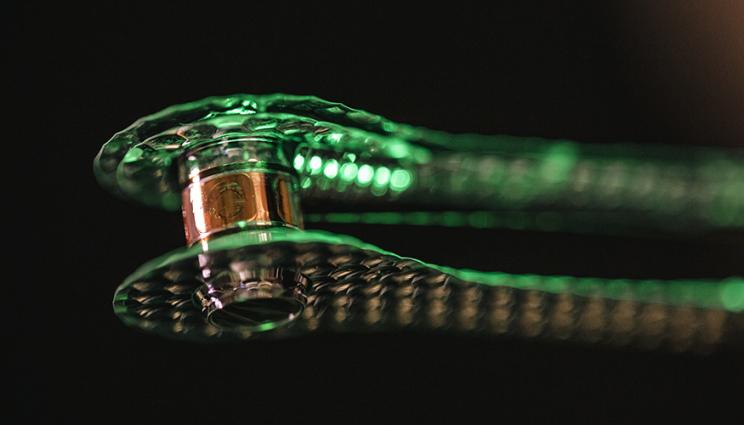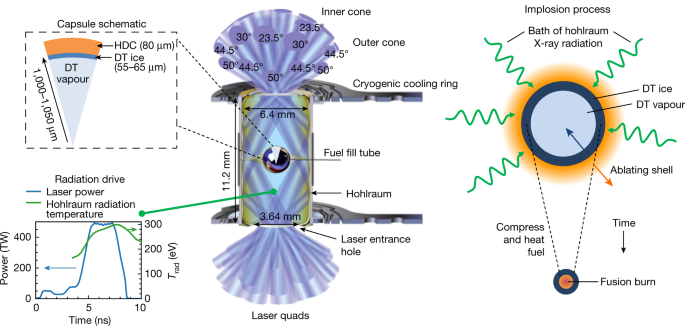Nature paper chronicles how researchers achieved burning plasma regime for the first time in a laboratory experiment
After decades of fusion research, a burning plasma state was achieved on November 2020 and February 2021 at Lawrence Livermore National Laboratory’s National Ignition Facility (NIF), the world’s most energetic laser.
Obtaining a burning plasma is a critical step toward self-sustaining fusion energy. A burning plasma is one in which the fusion reactions themselves are the primary source of heating in the plasma, which is necessary to sustain and propagate the burn to enable high-energy gain.
The work is detailed in the Jan. 26 issue of Nature
titled “Burning plasma achieved in inertial fusion,” with LLNL physicists Alex Zylstra and Omar Hurricane serving as lead authors.
“In this paper, we show that those experiments entered into what we call the burning plasma regime for the first time in the laboratory,” Zylstra said. “A burning plasma is one in which the fusion reactions provide most of the plasma heating.”
LLNL uses NIF to generate X-rays in a radiation cavity to indirectly drive a fuel-containing capsule via the X-ray ablation pressure. The implosion process compresses and heats the deuterium-tritium fuel via mechanical work.
“Fusion experiments over decades have produced fusion reactions using large amounts of ‘external’ heating to get the plasma hot. Now, for the first time, we have a system where the fusion itself is providing most of the heating,” Zylstra said. “This is a key milestone on the way to even higher levels of fusion performance.”
Getting fusion to work requires getting the power balance in the fuel right — there are always mechanisms that cause the plasma to lose energy, while fusion and the implosion’s compression heat the plasma.
Fusion is a highly non-linear process and, in this regime, researchers now have the opportunity to rapidly increase performance — in fact, this burning plasma work was a key stepping stone to the 1.3 MJ yield produced in August 2021. Generating these burning plasmas on NIF enables novel stewardship science experiments on both the burn physics and stockpile applications using the higher yield.
Designing and conducting these experiments was the work of a huge multidisciplinary team, with more than 150 coauthors on this publication from the Lab and partner institutions. Confirming that researchers had actually entered the burning plasma regime required using some inferred metrics, where a combination of measured quantities was used from several key diagnostics on NIF and models to infer the energy balance in the fusion fuel. This work was largely done in a working group that looks at analysis of the ‘hot spot,’ with conclusions validated by another working group of scientists at the Lab.
Reflecting the team effort, additional papers are coming soon on these burning plasma experiments. A paper describing the computational design work that led to these results is accepted for publication, with lead authors Annie Kritcher and Chris Young. Further analysis of the experiments in the new burning plasma regime is submitted for publication in a paper led by authors Steven Ross, Joe Ralph and Alex Zylstra.
https://www.llnl.gov/news/nature-paper-chronicles-how-researchers-achieved-burning-plasma-regime-first-time-laboratory?fbclid=IwAR2_PpGjeCZRWWlPRa8CdqYgnqmzsUbbnzUTqFRf3JC3ERqT6Gr6RgZSDqg
Burning plasma achieved in inertial fusion
Abstract
Obtaining a burning plasma is a critical step towards self-sustaining fusion energy1. A burning plasma is one in which the fusion reactions themselves are the primary source of heating in the plasma, which is necessary to sustain and propagate the burn, enabling high energy gain. After decades of fusion research, here we achieve a burning-plasma state in the laboratory. These experiments were conducted at the US National Ignition Facility, a laser facility delivering up to 1.9 megajoules of energy in pulses with peak powers up to 500 terawatts. We use the lasers to generate X-rays in a radiation cavity to indirectly drive a fuel-containing capsule via the X-ray ablation pressure, which results in the implosion process compressing and heating the fuel via mechanical work. The burning-plasma state was created using a strategy to increase the spatial scale of the capsule2,3 through two different implosion concepts4,5,6,7. These experiments show fusion self-heating in excess of the mechanical work injected into the implosions, satisfying several burning-plasma metrics3,8. Additionally, we describe a subset of experiments that appear to have crossed the static self-heating boundary, where fusion heating surpasses the energy losses from radiation and conduction. These results provide an opportunity to study α-particle-dominated plasmas and burning-plasma physics in the laboratory.
Main
Fusion research fundamentally aims to create a system that produces more energy than was required to create it, a necessary condition for energy applications; in practice, the fusion reaction must be self-sustaining, with self-heating overtaking loss mechanisms, termed ‘ignited’9. Such conditions are reached in astrophysical objects including the cores of stars, novae and type 1a supernovae, and in thermonuclear weapons. Ignition in the laboratory requires heating the fuel to incredibly high temperatures, where it becomes a ‘plasma’ and fusion reactions readily occur, while also controlling energy losses. Several approaches have been developed to heat and confine plasma over the past several decades, with most pursuing deuterium–tritium (DT) fuel, which most easily achieves ignition. The dominant approaches to plasma confinement are ‘inertial’, an impulsive burn while the fuel is confined by its own inertia, and ‘magnetic’, in which specialized configurations of magnetic fields provide confinement to the charged particles in the plasma. In order for a DT fusion (D + T → α (3.5 MeV) + n (14 MeV)) plasma to become thermally unstable and ignite, it must first obtain a ‘burning’ state. In this regime, self-heating from α-particle deposition exceeds the external heating input into the DT8; this ratio is denoted Qα, where the self-heating is taken relative to the heating power to the plasma—for inertial fusion this is the PdV compressional work on the fuel and not the total laser energy (P, pressure, dV, volume change). Qα > 1 is a burning plasma.
A burning-plasma state signifies a transformational change to the energy and power balance in the DT plasma, opening up the potential for rapidly increasing performance. In the impulsive case of inertial confinement fusion (ICF)10, Qα can be stated either as a power during burn, or as an energy integrated over the burn duration, whereas for the near-steady-state operation of magnetic fusion energy (MFE), Qα is a statement of power. As α-particles carry 1/5 of the total fusion energy per D + T reaction, Qα = Q/5, where Q is the total fusion energy compared to the heating energy supplied. (Or in the MFE case, stated in terms of total fusion power over heating power; for example, the goal of ITER11 is to reach Qα ≈ 2 (Q ≈ 10), whereas the record from the JET tokamak12 is Qα ≈ 0.13 (Q ≈ 0.67).)
A burning plasma is distinct from other scientific milestones in inertial fusion. In 2014, the first milestone of ‘fuel gain’13 (Gfuel > 1) was achieved14, in which the fusion yield exceeds the energy delivered to the fuel; this corresponds to approximately 12–14 kJ of yield at the National Ignition Facility (NIF). At 20–22 kJ, the yield was approximately doubled by self-heating feedback, termed ‘α-heating’15. The next scientific milestone is a burning plasma, as described previously; this is the scientific milestone achieved in this work. No net energy gain, G, relative to the laser energy is expected for a burning plasma. Because of energy losses incurred in achieving the required compressed state, ICF implosions must achieve ignition before a net energy gain is possible. A net energy gain would require fusion yields greater than the laser energy, 1.9 MJ. Although short of ignition or energy gain, a burning plasma (Qα > 1) is a new physics regime for laboratory fusion1,11,16. Studying burning plasmas will elucidate other new physics in this regime, such as self-heating-driven instabilities or kinetic effects in the plasma, which probably depend on the confinement approach.
In a tokamak, the predominant approach to magnetic confinement, once the plasma discharge is generated by resistive heating, external power sources, such as radio-frequency antenna, provide additional plasma heating as the plasma is brought to fusion conditions. In indirect-drive ICF, the way energy is delivered to the fusion fuel is different and much less direct. At NIF17, 192 lasers deliver up to 1.9 MJ of frequency-tripled light into a high atomic number (Z) ‘hohlraum’ (Fig. 1) that serves the purpose of an X-ray converter generating a nearly Planckian X-ray bath, an approach known as ‘indirect drive’18. The incident beam-by-beam laser pointing and power in time are designed6 to generate a specific radiation temperature (Trad) history (Fig. 1, bottom left) inside the hohlraum, with sufficient uniformity in a way that is matched to specifics of the target geometry and the desired final plasma state. The exposed surface of a capsule at the centre of the hohlraum absorbs approximately 10–15% of the X-rays, causing the outer edge of the capsule (the ablator) to ionize, generate high pressures of the order of hundreds of Mbar (1 Mbar = 1011 Pa), and expand away from the capsule—a process termed ablation. A shell of cryogenic DT fuel is layered against the inside surface of the ablator, which is in partial-pressure equilibrium with DT vapour in the centre of the capsule (Fig. 1, top left). The inwardly directed acceleration caused by the ablation drives the capsule and DT fuel inwards upon itself (an implosion, shown schematically at the right of Fig. 1) with enormous acceleration (about 1014 m s−2) obtaining velocities of approximately 350–400 km s−1 in a matter of nanoseconds. Most of the X-ray energy (about 92–95%) absorbed by the capsule is consumed by the ablation process, but as a result the DT fuel obtains considerable (about 10–20 kJ) kinetic energy inside a very small volume.
Centre, A typical indirect-drive target configuration with key engineering elements labelled. Laser beams (blue) enter the hohlraum through laser entrance holes at various angles. Top left, A schematic pie diagram showing the radial distribution and dimensions of materials in diamond (high-density carbon, HDC) ablator implosions. Bottom left, The temporal laser power pulse-shape (blue) and associated hohlraum radiation temperature (green). Right, At the centre of the hohlraum, the capsule is bathed in X-rays, which ablate the outer surface of the capsule. The pressure generated drives the capsule inward upon itself (an implosion) which compresses and heats the fusion fuel during the implosion process.
Shortly after the DT fuel acquires peak kinetic energy, the pressure (P) inside the implosion rises markedly, to levels of many hundreds of Gbar (1 Gbar = 1014 Pa), as kinetic energy is converted into internal energy in the DT (a process termed stagnation). An ICF implosion is a pressure amplifier, sacrificing absorbed energy to achieve high energy density and central pressures that are factors of thousands higher than the pressure at the ablation front. The high central pressure is necessary because only a small fraction of the energy at NIF can ever be coupled into the DT fuel, and heating a large mass of DT fuel is energetically costly, as reflected in the heat capacity of DT, cDT = 115 kJ mg−1 keV−1 (9.9 × 103 J kg−1 K−1). In these experiments the total fuel mass is approximately 200 μg and the hot-spot mass is approximately 20–30 μg. As a high ion temperature (Ti) is also needed for fusion, while the fuel stagnates at the centre of the implosion, the DT forms a hot spot from the fuel’s inner surface and PdV work is done on the hot spot, generating very high ion and electron temperatures in near thermal equilibrium (Ti ≈ Te ≈ 4–5 keV, 1 keV = 1.16 × 107 K, where Ti and Te are the ion and electron temperatures). If the conditions of high temperature and pressure are achieved, the hot spot initiates copious DT fusion reactions and self-heating further increases Ti.
https://www.nature.com/articles/s41586-021-04281-w?utm_medium=Social&utm_campaign=nature&utm_source=Facebook&fbclid=IwAR3va3lfd6ghvSBnsP5FE5LzhiWKR-c4Hlqsvg1AWyC9og8TQqgZpjmvdgk#Echobox=1643217510
Cite this article
Zylstra, A.B., Hurricane, O.A., Callahan, D.A. et al. Burning plasma achieved in inertial fusion. Nature 601, 542–548 (2022). https://doi.org/10.1038/s41586-021-04281-w


No hay comentarios:
Publicar un comentario